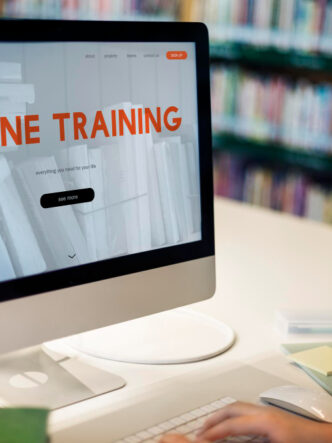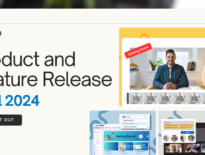We’ve become increasingly accustomed to the “new normal” in recent years. Case in point: online learning.
Digital learning environments, virtual lectures, video lessons – these are all common in educational settings today.
An online environment makes learning more accessible. But it’s crucial that you also provide an engaging experience if you want to give students the best chance at success.
In this article, we’ll discuss the importance of online learning engagement and give you some actionable tips for measuring and improving it.
What is online learning engagement?
During the COVID-19 pandemic, most institutions moved to an online environment.
This shift was driven by necessity, but online learning has proven itself a valuable tool. So it seems fully online and hybrid learning models are here to stay.
But if you offer online learning, how can you be sure students are getting the most out of it?
Learning engagement is a metric that measures:
- Cognitive engagement: How engaged online learners are with critical thinking, problem-solving, and self-regulation.
- Behavioral engagement: Looking at student participation and conduct.
- Collaborative engagement: How well fellow students work and communicate with each other.
- Emotional engagement: How students feel about their online classes, teachers, interaction with peers, and overall learning.
All of these offer insights into how invested students are in their virtual learning experience.
The power of engaging courses
Engaged students are more likely to actively participate in their education and learn more effectively, retaining what they’ve learned.
Research from Opportunity Education and Quest Forward Academies also indicates a strong correlation between learning engagement and course performance.

Image Source from OpporunityEducation.org
However, online education distances students from the emotional and behavioral functions of learning. Plus, it’s difficult to tell if an online student is engaged when they’re behind a screen.
Monitoring your students for signs that they’re not only paying attention but are actively invested in a lesson or course is vital to their success. If students are mentally checked out, being able to assess the problem and create a solution can get that student back on track.
6 metrics to measure online learning engagement
Let’s look at some of the most critical ways to measure online student engagement. Keep in mind that each of these metrics forms part of the puzzle, so it’s important to gather and view lots of data collectively.
-
Registration rates
Registration rates are easy to measure and offer data up-front before the learning even begins.
You can measure interest in your online courses by monitoring queries, contact rate figures, and sign-ups. These will all help you gain insight into how appealing your course appears.

Free to use image sourced from Unsplash
-
Completion and drop-out rates
Completion rates measure the number of students who complete your whole course or elements within it – for example, you may want to analyze how many people complete a particular module.
Measuring completion rates can give you an overall picture of learner engagement. A high failure rate or number of drop-outs might indicate that your content is difficult, uninteresting, or irrelevant.
-
Time spent on tasks
Online learning tools allow you to measure how much time each student spends on each task. This includes online lectures, discussions, coursework, and class activities.
More time spent might indicate higher engagement levels. Alternatively, time spent might tell you about issues with your material.
Struggling students might spend more time on tasks but still feel unengaged if they’re finding it challenging to complete. Other students might breeze through work and still feel unengaged because the material is too easy.
-
Interaction
It’s crucial to determine how well students interact with their teachers and peers as well as learner-content interaction, which measures how often students interact with touchpoints.
Behaviors you might measure include:
- Clicking on links
- Participating in a discussion board
- Posting comments
- Engaging with interactive features like quizzes and games
- Taking notes
- Watching video tutorials
- Taking part in optional activities

Free to use image sourced from Unsplash
-
Student feedback
While quantitative data is important, when it comes to engagement, qualitative data is just as valuable, if not more. Students’ emotions and perceptions extend beyond simple numbers.
Taking online student feedback can give you valuable insights into how students feel about their online learning experience.
Offering ways for students to give feedback shows you care about their opinions and are invested in improving their experience. This also builds trust between you and your students and empowers them to be more engaged.
You can collect feedback in various ways, including:
- Issuing feedback surveys
- Opening up communication channels like email or instant messaging
- Checking in with how students are feeling after every lesson or activity
-
Academic performance outcomes
Outcomes exist beyond completion and drop-out rates. As we mentioned earlier, engaged learners perform better, and outcomes are the ultimate performance indicator.
A KPI report will help you track success metrics like scores, points, and grades so you can evaluate student performance and determine areas of engagement. You can measure academic performance on assignments, coursework, group and solo projects, and tests.
These KPIs might also flag students at risk of becoming disengaged. If a student’s initial high grades begin to decline, it could be a sign that they need additional support.
How to improve engagement in an online environment

Free to use image sourced from Pexels
With the above metrics and students’ feedback in mind, you can begin to optimize the learning experience. Here are the essential steps to follow.
Lay a foundation
A 2022 study on online learning engagement during COVID-19 showed that 72% of students reported low engagement during lectures damaged their online learning experience. Why? Institutions didn’t have time to properly prepare students for the virtual environment.
Most students are familiar with learning in a classroom environment, but online lectures are a big shift from the norm.
Preparing students for their online learning experience can go a long way to helping them acclimate. So, how can you do this?
- Write a friendly introduction email to let students get to know you.
- Send a course overview with details about modules, activities, and expectations. Utilize an AI scheduler to help create, maintain, and share timetables.
- Send a list of any tools and reading materials students will need.
- Prepare an instructional guide about online learning and what students should expect.
- Prepare detailed instructions about your online learning platform and how to use each feature and tool.
- Record a tutorial video to go along with your instructions where you show students how to use your online learning platform.
- Ask students for feedback up-front. Let students know they can ask questions and clarify anything they’re worried or confused about.
Helping students connect with you and your course from the get-go is a great way to create confidence and start with a high level of engagement.
Design clear and cohesive content
In online learning spaces, the lack of face-to-face interaction makes it difficult to monitor every online student for signs of confusion. Remote students also have fewer opportunities to ask questions or discuss problems with you and other classmates.
This makes it all the more vital to ensure your online content is high-quality. And there are plenty of ways to get creative here.
You can incorporate activities, discussions, games, videos and images. You can also link external resources with relevant content that complements your course material.
Create a sense of community
We think of real-life interaction as the epitome of community, but online communities can be just as powerful.
Both teachers and students can participate in online communities. If you’re looking to expand your enterprise payroll, adding a few more teachers to your service can’t hurt.
Online learning can leave students feeling isolated and unengaged. Creating a sense of community can encourage peer interaction, discussion, friendships, brainstorming, and knowledge sharing.
Add gamification elements
Gamification has captivated people since the early days of the internet. Even the writers of TV show Lost developed alternate reality games (ARGs) to engage audiences on a new level.
These ARGs mixed online videos and puzzles with real-world exploration and rewards. Participants collaborated in online forums to solve mysteries, met up in real life to visit important locations, unlocked further material, and received rewards.
This type of gamification like this can synergize well with online learning. It ticks every student engagement box: collaborative, emotional, cognitive, and behavioral.
You can use gamification methods to encourage students to engage with various types of content. You can create interactive videos, design a rewards system that gives students points or prizes, and connect your online course material with real-world consequences.

Free to use image sourced from Unsplash
The interactive nature of gamification is also a great way to measure engagement. You can track how many students click on links, watch videos, and participate in challenges.
Utilize feedback
As we mentioned, student feedback is vital for measuring online learning engagement and making students feel heard.
But you have to make sure you act on feedback. Analyze answers to surveys and track patterns. As you spot trends in bottlenecks or issues that are hindering engagement, identify ways to overcome them. Collect feedback again to make sure your changes are effective.
It’s also important to provide feedback to your students in return. Continuous feedback helps them improve and gives you opportunities to look for signs of disengagement.
Empower students by optimizing online learning engagement
Educators understand the importance of learning engagement. Teachers are always searching for new ways to encourage and advise students toward success.
To improve something, you need to understand what’s working and what isn’t.
That’s where online learning shines. Online platforms allow you to collect data and evaluate your approach. You can look for places where students are disengaged and utilize the information to make improvements.
The digital world is reshaping modern education. So it’s vital to measure engagement and outcomes to help students succeed in this new landscape.










